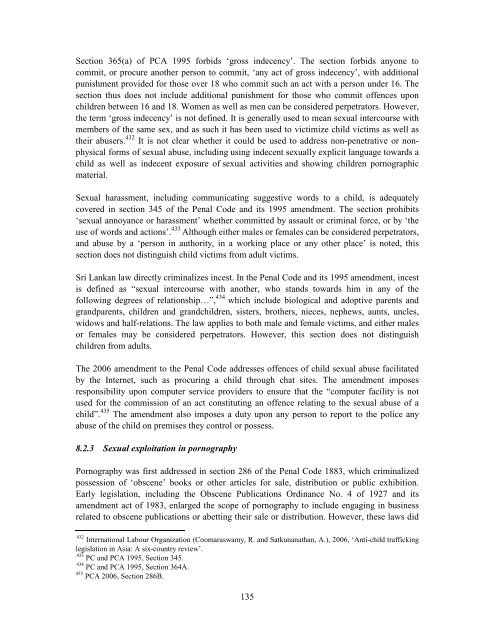SEXUAL ABUSE AND EXPLOITATION OF BOYS IN SOUTH ASIA A ...
SEXUAL ABUSE AND EXPLOITATION OF BOYS IN SOUTH ASIA A ...
SEXUAL ABUSE AND EXPLOITATION OF BOYS IN SOUTH ASIA A ...
Create successful ePaper yourself
Turn your PDF publications into a flip-book with our unique Google optimized e-Paper software.
Section 365(a) of PCA 1995 forbids ‘gross indecency’. The section forbids anyone to<br />
commit, or procure another person to commit, ‘any act of gross indecency’, with additional<br />
punishment provided for those over 18 who commit such an act with a person under 16. The<br />
section thus does not include additional punishment for those who commit offences upon<br />
children between 16 and 18. Women as well as men can be considered perpetrators. However,<br />
the term ‘gross indecency’ is not defined. It is generally used to mean sexual intercourse with<br />
members of the same sex, and as such it has been used to victimize child victims as well as<br />
their abusers. 432 It is not clear whether it could be used to address non-penetrative or nonphysical<br />
forms of sexual abuse, including using indecent sexually explicit language towards a<br />
child as well as indecent exposure of sexual activities and showing children pornographic<br />
material.<br />
Sexual harassment, including communicating suggestive words to a child, is adequately<br />
covered in section 345 of the Penal Code and its 1995 amendment. The section prohibits<br />
‘sexual annoyance or harassment’ whether committed by assault or criminal force, or by ‘the<br />
use of words and actions’. 433 Although either males or females can be considered perpetrators,<br />
and abuse by a ‘person in authority, in a working place or any other place’ is noted, this<br />
section does not distinguish child victims from adult victims.<br />
Sri Lankan law directly criminalizes incest. In the Penal Code and its 1995 amendment, incest<br />
is defined as “sexual intercourse with another, who stands towards him in any of the<br />
following degrees of relationship…”, 434 which include biological and adoptive parents and<br />
grandparents, children and grandchildren, sisters, brothers, nieces, nephews, aunts, uncles,<br />
widows and half-relations. The law applies to both male and female victims, and either males<br />
or females may be considered perpetrators. However, this section does not distinguish<br />
children from adults.<br />
The 2006 amendment to the Penal Code addresses offences of child sexual abuse facilitated<br />
by the Internet, such as procuring a child through chat sites. The amendment imposes<br />
responsibility upon computer service providers to ensure that the “computer facility is not<br />
used for the commission of an act constituting an offence relating to the sexual abuse of a<br />
child”. 435 The amendment also imposes a duty upon any person to report to the police any<br />
abuse of the child on premises they control or possess.<br />
8.2.3 Sexual exploitation in pornography<br />
Pornography was first addressed in section 286 of the Penal Code 1883, which criminalized<br />
possession of ‘obscene’ books or other articles for sale, distribution or public exhibition.<br />
Early legislation, including the Obscene Publications Ordinance No. 4 of 1927 and its<br />
amendment act of 1983, enlarged the scope of pornography to include engaging in business<br />
related to obscene publications or abetting their sale or distribution. However, these laws did<br />
432 International Labour Organization (Coomaraswamy, R. and Satkunanathan, A.), 2006, ‘Anti-child trafficking<br />
legislation in Asia: A six-country review’.<br />
433 PC and PCA 1995, Section 345.<br />
434 PC and PCA 1995, Section 364A.<br />
435 PCA 2006, Section 286B.<br />
135










